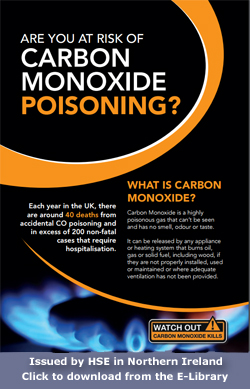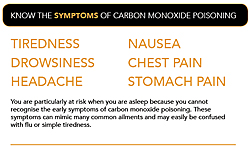Reduce the Risk of Carbon Monoxide Poisoning Over The Winter
 Dave Joyce, CWU's National Health, Safety & Environment Officer has issued a letter to all CWU branch Secretaries, highlighting the annual Carbon Monoxide awareness campaign month being run by charity organisations in the UK.
Dave Joyce, CWU's National Health, Safety & Environment Officer has issued a letter to all CWU branch Secretaries, highlighting the annual Carbon Monoxide awareness campaign month being run by charity organisations in the UK.
Whilst the HSE previously highlighted the campaign, their website is now devoid of much of its previous campaigning pages, making their support for this event very difficult to find. Meanwhile, the HSE in Northern Ireland continues to prominently promote this very important event.
In his LTB 685/2016, Dave explains the issues concerned and the reasons why this campaign is so crucial:
A number of Organisations are running Awareness Campaigns during November and December, including the County Fire and Rescue Services, Public Health England, HSE and HSE(NI), Gas Safe, British Gas and others, to raise the awareness of the serious effects of carbon monoxide poisoning and the devastating consequences it can have on people’s lives.
Following action to highlight the risks from carbon monoxide poisoning by Government, PHE, industry, campaign groups and others, the number of deaths from CO poisoning fell but between 2014 and 2016 there has been a worrying 10% increase in accidental CO deaths in the UK.
So the CWU Health, Safety & Environment Department is reminding everyone of the dangers of Carbon Monoxide poisoning.
Death & Injury Toll
Recent analysis revealed the hidden toll, each year, from this dangerous invisible gas:
- 4,000 people go to A&E
- 200 people are hospitalised
- There are around 60 deaths in the UK
Silent Killer
CO is produced by the incomplete combustion of solid, liquid, and gaseous fuels. It is a highly poisonous gas which is impossible to see, taste or smell and is often known as the ‘silent killer’. Under normal circumstances, CO should not be detectable in the typical home or workplace. When appliances are kept in good working condition, they produce little CO.
It is difficult to detect because you can’t see, smell or taste it. Many CO poisoning deaths take place between November and February due to faulty heating appliances and boilers leaking this lethal gas. To lower the risk, we recommend that people should ensure that their fossil fuel and wood burning appliances are regularly checked by an appropriately registered engineer.
In addition, people should fit an audible CO alarm which meets European Standards EN 50291 in each room containing an appliance and ensure rooms are adequately ventilated. It's recommends that people have these appliances and their flues checked before the start of winter, which is when most of the accidental deaths occur.
Key Facts
- Carbon monoxide (CO) poisoning can be fatal or cause permanent damage to your health.
- CO is produced when carbon fuels don’t burn completely.
- It has no smell or taste and, in large quantities, it can kill very quickly.
What's carbon monoxide?
It’s a poisonous gas that you can’t see, smell or taste – you might not know it’s there. Carbon monoxide is released when faulty appliances start leaking. Low exposure to the gas can cause long-term damage, and high levels of exposure can be fatal. Every year, around 30 people die from carbon monoxide poisoning – and many more fall sick.
How is carbon monoxide produced?
- Carbon monoxide is hard to detect because it has no smell, taste or colour. This also means that it is easy to inhale without realising.
- Carbon monoxide is produced when fuels such as gas, oil, coal and wood do not burn fully.
- When a fire burns in an enclosed room, the oxygen in the room is gradually used up and replaced with carbon dioxide. Following a build-up of carbon dioxide in the air, the fuel is prevented from burning fully and it starts to release carbon monoxide.
Causes of carbon monoxide poisoning 
Many homes and businesses use appliances that burn fuels such as gas, oil and coal, peat and wood. If these appliances are not installed, maintained, and used properly, carbon monoxide (CO) can build up to dangerous and even deadly levels, particularly in poorly ventilated areas.
Using kerosene heaters or charcoal grills indoors, or running a car or van in a garage, can also cause levels high enough to result in CO poisoning. Common sources of CO include the following Gas, oil, coal and wood fuel source appliances, including:
- boilers
- gas fires
- central heating systems
- water heaters
- cookers
- open fires
- room heaters
- furnaces
- charcoal grills
- cooking ranges
- water heaters
- vehicles run in closed garages
- fireplaces
- portable generators
- wood-burning stoves
Appliances such as electrical heaters, electric water heaters and toasters do not produce CO under any circumstances.
If the fuel in these appliances does not burn fully, carbon monoxide (CO) gas is produced. The build-up of carbon monoxide can also be as a result of any of the following:
- Indoor use of a barbecue grill or outdoor heater
- Using cooking appliances for heating purposes
- Enclosed or unventilated spaces – burning fuel in an enclosed or unventilated space, where there are no air vents, windows or doors left open or ajar
- Faulty or damaged appliances – heating or cooking
- Heating appliance not maintained or serviced
- Badly ventilated rooms – sealed windows, no air bricks
- Blocked chimneys or flues – birds’ nests, fallen bricks, growing vegetation, bad DIY
- Poor or improper installation or use of appliances – such as cooking and heating devices
- Running engines such as cars or lawnmowers in garages
- Old appliances that have not been serviced or looked after properly
- Paint fumes – Fumes from cleaning fluids and paint removers that contain methylene chloride (dichloromethane) can also cause CO poisoning
Danger signs
Danger signs that CO may be leaking include:
- yellow or orange flames where there should normally be blue ones
- sooty stains on the walls around fires and water heaters. You could also be poisoned by CO if you share a wall or chimney with a house that has a CO leak, even if your own house does not have one.
Advice
Get fossil fuel and wood burning appliances like boilers, heaters and cookers checked by an appropriately registered engineer before winter sets in.
The Gas Safe Register
The Gas Safe Register estimates there are around 7,500 illegal gas fitters operating across the UK, and up to 250,000 illegal gas jobs may be carried out each year. All persons employed to work on gas appliances in the United Kingdom, the Isle of Man and Guernsey must be registered with the Gas Safe Register in order to work lawfully. Always check that any engineer undertaking work is 'Gas Safe registered'.
Go to the 'Gas Safe Register Website' at: https://www.gassaferegister.co.uk or alternatively call the freefone helpline on 0800 408 5500.
Best protection
The best way to protect against carbon monoxide is to make sure all fuel-burning appliances are properly installed by recognised and established engineers, and serviced by competent companies or individuals - at least once a year. Always follow the manufacturer's instructions for boilers, stoves, gas fires and solid fuel room heaters. Don’t forget that chimneys and flues should also be inspected annually and swept, if required, by a registered technician.
CO alarms
 As a back-up measure, you should also install an audible carbon monoxide alarm – these are widely available to buy from supermarkets, DIY stores or online retailers. Some people may have had CO alarms fitted in the home or workplace for a number of years. However, CO alarms have a limited life span, so they should be checked to see if it is working properly. It might be time to be replaced. Remember, while carbon monoxide alarms can help alert people to the dangers if CO gas escapes, they must never be regarded as a substitute for the proper installation, maintenance, servicing and cleaning of appliances that use gas, coal, oil or any other solid fuel.
As a back-up measure, you should also install an audible carbon monoxide alarm – these are widely available to buy from supermarkets, DIY stores or online retailers. Some people may have had CO alarms fitted in the home or workplace for a number of years. However, CO alarms have a limited life span, so they should be checked to see if it is working properly. It might be time to be replaced. Remember, while carbon monoxide alarms can help alert people to the dangers if CO gas escapes, they must never be regarded as a substitute for the proper installation, maintenance, servicing and cleaning of appliances that use gas, coal, oil or any other solid fuel.
Away from home
We normally associate CO with domestic fossil-fuel burning appliances and most of us are aware of its dangers in the home. However, incidents and fatalities relating to CO can also occur in holiday homes, caravans and on board boats where faulty gas cookers, appliances or petrol-powered generators have led to carbon monoxide poisoning. So, make sure all appliances are properly installed and are serviced regularly. Carbon Monoxide poisoning can also occur when people bring gas and charcoal BBQs into tents and other small enclosed spaces, sometimes in an attempt to keep warm.
Symptoms
Early symptoms of Carbon Monoxide (CO) poisoning can mimic many common ailments and may easily be confused with food poisoning, viral infections, flu or simple tiredness. Exposure to high concentration levels of CO, even for a short time, can render a person gradually becoming unconscious. Unfortunately many people do not recover from the unconscious phase. Symptoms to look out for include:

- headache
- nausea
- breathlessness
- drowsiness
- dizziness
- chest pains
- nausea and vomiting
- collapse
- unconsciousness
At high levels, CO poisoning can cause sudden collapse, loss of consciousness and death. If you or your family or colleagues experience any of the above symptoms and you believe CO may be involved, you must seek urgent medical advice from either a doctor or go to an accident and emergency department. You should ask for a blood or breath test to confirm the presence of CO. Be aware, CO quickly leaves the blood and tests may be inaccurate if taken more than four hours after exposure has ceased.
What to do in an emergency
If you suspect carbon monoxide is present, remember to follow the ‘TASK’ checklist:
- T- turn off or extinguish the heating source/appliance if safe to do so
- A - air - ventilate your home by opening windows and doors, stay outside in the fresh air
- S - seek medical help if you feel unwell
- K - keep all heating sources/appliances off until serviced (or chimney/flues cleaned) by a qualified professional
Contact Numbers
These organisations can help if you think you have a carbon monoxide leak:
Gas Emergency Services 0800 111 999 - Lines are open 24 hours a day, 7 days a week
Scottish Gas Emergency Number 0843 557 4307
NI Gas Emergency Service (24 hours) 0800 002 001
Gas Safe Register 0800 408 5500 Lines are open Monday to Thursday, 9am-5.30pm, and Fridays, 9am-5pm.
NHS 111 for advice.
Public Health England 020 7654 8000
Public Health Scotland (ISD) 0131 275 7777
Public Health Agency (NI) 028 9031 1611
Public Health Wales 029 2022 7744
Oil Firing Technical Association (OFTEC) helpline: 0845 65 85 080
Solid Fuel Association (SFA) helpline: 0845 601 4406
HETAS (for registered solid fuel engineers): 01684 278170
The various information leaflets and poster can be found in this website's E-Library using search category 'Gas Safety'
Source: CWU / HSE NI


 Dave Joyce, CWU's National Health, Safety & Environment Officer has issued a letter to all CWU branch Secretaries, highlighting the annual Carbon Monoxide awareness campaign month being run by charity organisations in the UK.
Dave Joyce, CWU's National Health, Safety & Environment Officer has issued a letter to all CWU branch Secretaries, highlighting the annual Carbon Monoxide awareness campaign month being run by charity organisations in the UK.

